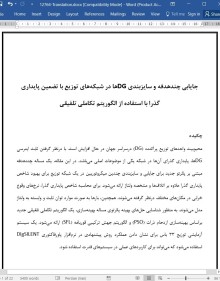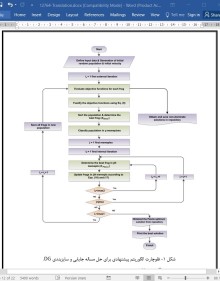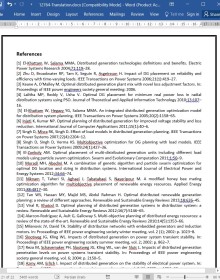
دانلود مقاله جایابی چندهدفه و سایزبندی DGها در شبکه های توزیع با تضمین پایداری گذرا
چکیده
محبوبیت واحدهای توزیع پراکنده (DG) درسراسر جهان در حال افزایش است. با درنظر گرفتن ثابت اینرسی DGها، پایداری گذرای آن ها در شبکه یکی از موضوعات اصلی می باشد. در این مقاله، یک مساله چندهدفه مبتنی بر پائرتو جدید برای جایابی و سایزبندی چندین میکروتوربین در یک شبکه توزیع برای بهبود شاخص پایداری گذرا علاوه بر اتلاف ها و مشخصه ولتاژ ارائه می شود. برای محاسبه شاخص پایداری گذرا، نرخ های وقوع خرابی در مکان های مختلف درنظر گرفته می شوند. همچنین، بارها به صورت موارد توان ثابت و وابسته به ولتاژ مدل می-شوند. به منظور شناسایی حل های بهینه پائرتوی مساله بهینه سازی، یک الگوریتم تکاملی تلفیقی جدید براساس بهینه سازی ازدحام ذرات (PSO) و الگوریتم جهش ترکیبی قورباغه (SFL) ارائه می شود. یک سیستم آزمایشی توزیع 33 باس برای نشان دادن عملکرد روش پیشنهادی در نرم افزار پاورفاکتوری DIgSILENT استفاده می شود که می تواند برای کاربردهای عملی در سیستم های قدرت استفاده شود.
1- مقدمه
تولید پراکنده نقش مهمی و حیاتی در سیستم های قدرت نوظهور ایفا خواهد کرد. مطالعات نشان می دهند که DG یک درصد قابل توجهی از تمام تولیدات نصب شده جدید خواهد بود {1}. افزایش نفوذ DG در سیستم توزیع موجب تاثیر قابل توجه بر جریان توان، مشخصه ولتاژ، اتلاف ها، پایداری، پیوستگی سطح اتصال کوتاه، و کیفیت منبع تغذیه برای مشتریان و تامین کنندگان برق می شود. بنابراین، درنظر گرفتن برخی جنبه ها در مساله بهینه سازی برای بهترین جایابی و سایزبندی واحدهای DG ضروری است. کارهای جالب بسیاری برای سروکار داشتن با این مساله انجام شده است. تفاوت های اصلی میان این مطالعات مربوط به فرمول بندی، روش حل و فرضیات مساله می باشند. در {2،3}، تنها جایابی DG بهینه در سیستم توزیع بررسی شد. چندین فاکتور در این کارها مانند کارایی سیستم کلی، قابلیت اطمینان سیستم، تغییر بار، مشخصه ولتاژ، اتلاف های سیستم و فاکتورهای تطبیق اتلاف DG مطالعه شدند. هر دو جایابی DG و سایزبندی در یک مساله بهینه سازی در {4-11} انجام شدند. مکان و سایز یک واحد DGدر {4} تنها برای کمینه سازی اتلاف های سیستم تعیین می شود. نویسندگان {5} یک مدل بهینه سازی جامع و تجربه برنامه ریزان را در سناریوهای مختلف برای برنامه ریزی توزیع بهینه ترکیب می کنند. هدف این مدل کمینه کردن خطر سرمایه گذاری و هزینه های مختلف براساس سناریوهای متنوع می باشد. یک روش تحلیلی جدید و یک روش منطق فازی در {6} برای محاسبه سایز و مکان DG بهینه استفاده می شوند. فاکتورهای بررسی شده اتلاف های توان فعال و واکنشی و شاخص پایداری ولتاژ می باشند. اثر مدل های بار مختلف بر یک برنامه ریزی توزیع پراکنده یک هدفه و چندهدفه به ترتیب در {7،8} بررسی می شود. نشان داده می شود که مدل ها بار می توانند به طور قابل توجهی بر مساله جایابی و سایزبندی DG در شبکه های توزیع تاثیر بگذارند. در {9}، الگوریتم PSO برای بهینه سازی یک شاخص چندهدفه استفاده شد. این شاخص شامل اتلاف های توان فعال و واکنشی، مشخصه ولتاژ، ظرفیت MVA، و سطح اتصال کوتاه می باشد. مدل های بار مختلف در {9} درنظر گرفته شده اند. در {10}، یک الگوریتم PSO و ژنتیک مرکب ارائه می شود و سپس یک شاخص چندهدفه بادرنظر گرفتن اتلاف های توان فعال، تنظیم ولتاژ و پایداری ولتاژ توسط این الگوریتم بهینه می شود. در {11}، الگوریتم بهینه سازی جفت گیری زنبور عسل تعمیم یافته (HBMO) در یک چارچوب چندهدفه مبتنی بر پائرتو برای محاسبه جایابی و سایزبندی چندین DG ارائه شده است درحالیکه توابع هدف رقابتی این مطالعه به کمینه سازی هزینه ها، انتشار و اتلاف های سیستم پراکنده و به بهبود مشخصه ولتاژ اشاره دارند. درنهایت، بررسی جنبه های مربوط به برنامه ریزی DG مخصوصا جایابی DG در {12-14} فراهم می شوند، جاییکه چالش ها، روندها و آخرین توسعه های آن ها ارائه می شوند.
5- نتیجه گیری
در این مقاله، یک چارچوب بهینه سازی چندهدفه ایمن برای جایابی و سایزبندی DG در سیستم های توزیع استفاده شده است. توابع هدف رقابتی شامل کمینه سازی اتلاف ها و انحراف های ولتاژ و همچنین بهبود پایداری گذرای DGها می باشند. برای این منظور، چندین ماکروتوربین به صورت DG استفاده می شوند. تابع پایداری گذرا با استفاده از شاخص CCT در مورد استفاده از عوامل مختلف مربوط به مکان های خرابی مختلف محاسبه می شود. همچنین، برای حل مساله بهینه سازی، یک تکنیک تلفیقی جدید براساس ترکیب الگوریتم های PSO و SFL برای سود بردن از مزیت های هر دوی آن ها ارائه می شود. در روش چندهدفه، حل های متفاوت تولید و سپس ارجح-ترین حل بهینه پائرتو در میان آن ها با استفاده از یک ابزار تصمیم گیری فازی انتخاب می شوند. به منظور به دست آوردن یک نتیجه دقیق تر، تمام شبیه سازی ها در نرم افزار ®DIgSILENT با مدل سازی دینامیکی و در نظر گرفتن مدل های بار وابسته به ولتاژ مختلف انجام می شوند. چارچوب پیشنهادی به اپراتورهای سیستم های توزیع برای در نظر گرفتن موضوعات امنیت دینامیکی علاوه بر جنبه های مهم دیگر و سازگاری با اهداف متعارض روش جایابی و سایزبندی DG اجازه می دهد. کارهای تحقیقاتی بیشتری در این زمینه برای در بر گرفتن توابع هدف مبتنی بر امنیت بیشتر (مانند مرز پایداری سیگنال و کوچک) و برای در نظر گرفتن انواع دیگر DGها وجود دارند.
Abstract
Distributed generation (DG) units are increasing their popularity around the world. Considering the low inertia constant of DGs, the transient stability of them in the network is one of the major issues. In this paper, a new Pareto-based multi-objective problem is proposed for the placement and sizing of multiple micro-turbines in a distribution network to improve the transient stability index in addition to the losses and voltage profile. To calculate the transient stability index, the rates of fault occurrence in the different locations are considered. Also, the loads are modeled as both constant power and voltage dependent cases. In order to identify Pareto optimal solutions of the optimization problem, a novel hybrid evolutionary algorithm based on the Particle Swarm Optimization (PSO) and Shuffled Frog-Leaping (SFL) algorithm is presented. A 33-bus distribution test system is used to demonstrate the performance of the proposed method in DIgSILENT® PowerFactory software which can be used for practical applications in power systems.
1. Introduction
Distributed generation will play an important and crucial role in emerging power systems. Studies show that DG will be a significant percentage of all new installed generations [1]. Increasing DG penetration in distribution system causes a significant impact on the power flow, voltage profile, losses, stability, continuity, short circuit level, and quality of power supply for customers and electricity suppliers. Therefore, it is necessary to consider some aspects in optimization problem for the best placement and sizing of DG units. Many interesting works have been developed to deal with this problem. The main differences among these studies refer to the formulation, solution methodology and assumptions of the problem. In [2,3], only the optimum DG placement was investigated in the distribution system. Several factors were studied in these works such as the overall system efficiency, system reliability, load variation, voltage profile, system losses and DG loss adjustment factors. Both DG placement and sizing in one optimization problem were performed in [4–11]. The location and size of a single DG unit is determined in [4] to only minimize the network losses. The authors of [5] integrate a comprehensive optimization model and planner's experience in different scenarios for optimum distribution planning. The aim of this model is to minimize the investment risk and different costs according to the alternative scenarios. A new analytical method and a fuzzy logic approach are used in [6] to calculate the optimal DG size and location. The investigated factors are the active and reactive power losses and voltage stability index. Effect of different load models on a single objective and a multi-objective distributed generation planning is investigated in [7,8], respectively. It is shown that the load models can significantly affect the problem of DG placement and sizing in distribution networks. In [9], the PSO algorithm was employed to optimize a multi-objective index. This index contains active and reactive power losses, voltage profile, MVA capacity, and short circuit level. Different load models have been considered in [9]. In [10], a combined PSO and genetic algorithm is presented and then a multi-objective index considering active power losses, voltage regulation and voltage stability is optimized by this algorithm. In [11], improved honey bee mating optimization (HBMO) algorithm has been proposed in a Paretobased multi-objective framework to calculate sitting and sizing of multiple DGs while the competing objective functions of the study refer to minimize costs, emission and losses of distributed system and to enhance voltage profile. Eventually, the review of the relevant aspects related to DG planning notably DG placement are provided in [12–14], where their challenges, trends and latest developments are presented.
5. Conclusions
In this paper a secure multi-objective optimization framework has been presented for DG placement and sizing in the distribution systems. The competing objective functions consist of minimizing the losses and voltage deviations as well as improving transient stability of DGs. For this purpose, multiple microturbines are used as DGs. The transient stability function is calculated using CCT index in the case of applying different contingencies related to the various fault locations. Also, to solve the optimization problem, a new hybrid technique is proposed based on the combination of PSO and SFL algorithms to benefit from the advantages of both of them. In the multi-objective approach, the efficient solutions are generated and then the most preferred Pareto optimal solution are selected among them applying a fuzzy decision making tool. In order to obtain a more precise result, all simulations are carried out in DIgSILENTs software with dynamic modeling and considering different voltage-dependent load models. The proposed framework permits the distribution system operators to consider the dynamic security issues in addition to other important aspects, and to compromise the conflicting objectives of the DG placement and sizing procedure. There are some future research works in this area to incorporate more security based objective functions (e.g. small signal stability margin) and to consider other types of DGs.
چکیده
1- مقدمه
2- فرمول بندی مساله
2-1 توابع هدف
2-1-1 کمینه سازی اتلاف های توان
2-1-2 بهبود مشخصه ولتاژ
2-1-3 بهبود پایداری گذرا
2-2 قیدها
2-2-1 حد ولتاژ
2-2-2 قیدهای فنی ولتاژ
2-2-3 حدهای جریان توان شاخه ای
2-3 مدل های بار
3- روش حل
3-1 فرمول بندی چندهدفه مبتنی بر فازی
3-2 الگوریتم تکاملی تلفیقی پیشنهادی
4- نتایج عددی
4-1 ارزیابی الگوریتم پیشنهادی
4-2 پیاده سازی مساله چندهدفه پیشنهادی
5- نتیجه گیری
منابع
Abstract
1. Introduction
2. Problem formulations
2.1. Objective functions
2.1.1. Minimizing the power losses
2.1.2. Improving the voltage profile
2.1.3. Improving the transient stability
2.2. Constraints
2.2.1. Voltage limit
2.2.2. DG technical constraints
2.2.3. Branch power flow limits
2.3. Load models
3. Solution approach
3.1. Fuzzy based multi-objective formulation
3.2. Proposed hybrid evolutionary algorithm
4. Numerical results
4.1. Evaluation of proposed algorithm
4.2. Implementation of the proposed multi-objective problem
5. Conclusions
References
- ترجمه فارسی مقاله با فرمت ورد (word) با قابلیت ویرایش، بدون آرم سایت ای ترجمه
- ترجمه فارسی مقاله با فرمت pdf، بدون آرم سایت ای ترجمه



